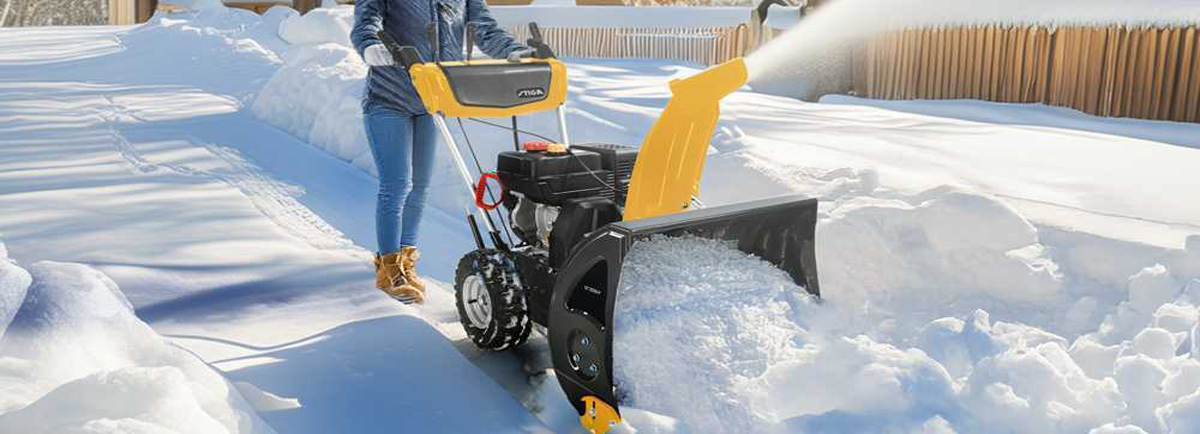A complete guide to snow blower maintenance, completed and edited by real Maintenance Experts.
The snow blower is an indispensable ally for clearing driveways, roads and yards of snow.
In order to ensure the optimal functioning and long life of this instrument, it is essential to carry out proper maintenance.
But what interventions are needed? Which components of the snow thrower require the most attention?
In this in-depth guide, we will walk you through all the steps of snow blower maintenance, from preparing for the early season, through routine operations during use, to the procedures required for storage at the end of the season.
CONTENTS
The maintenance steps of the snow blower
As mentioned in the introduction, we can summarize the maintenance of a snow blower in three main stages throughout the season:
- Early season maintenance: All the maintenance that prepares the snow blower for the season;
- Routine maintenance: All maintenance work must be carried out regularly throughout the season when the machine is in use;
- Storage operations: Work to be carried out between the end of March and the beginning of April, before storing the snow blower for months of storage.
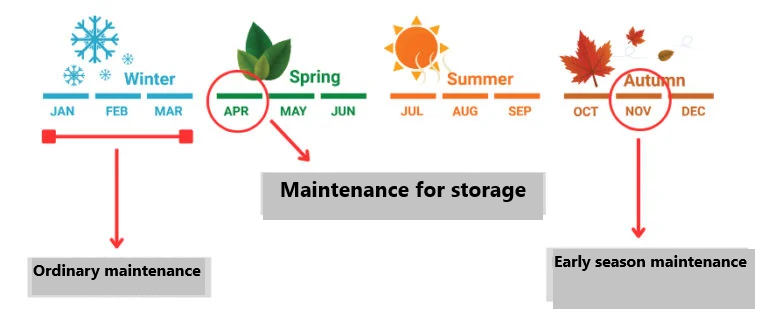
Before we look at all the different maintenance steps, we assume that the most popular snow blower models are those with an internal combustion engine, this category also requires most maintenance, due to the various components that are more subject to inspection and wear such as: engine oil, spark plugs etc…
That is why we will look specifically at all the general tasks to be carried out on snow blowers, as well as all those that are closely related to the internal combustion engine and its components.
1. Early season maintenance
Before the winter cold and the first snowfalls arrive, which is roughly between October and November, it is essential to prepare your snow blower to cope for the upcoming season.
Early season maintenance focuses on checking and preparing the main components, ensuring that the snow blower is ready.
We can summarise the maintenance work at the beginning of the season as follows:
- Refuelling;
- Control of the engine and starting system;
- Changing engine oil;
- Checking or replacing the spark plug
- Checking the condition of the blades and the auger;
- Inspection of the tires or tracks;
- Checking the transmission, belts and snow discharge system.
IMPORTANT: Winterized’ engines are lacking an air filter because working at low temperatures and with snow could create moisture that would then freeze, ruining the filter and creating problems for the machine’s operation.
What is meant by the ‘Winterized’ engine?
A winter engine is an engine that has been specially prepared or modified to operate in cold winter conditions, characterised by low temperatures and potentially ice or snow.
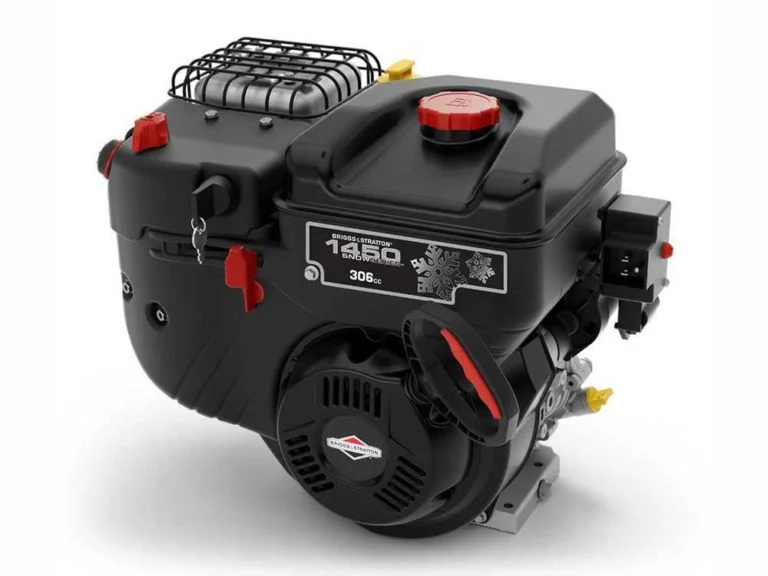
The main features of a ‘winterized’ engine include:
- Optimised starting system : to facilitate ignition in cold weather;
- Use of specific oils and lubricants : formulated to maintain the fluidity and protection of the engine even at very low temperatures;
- Frost protection : such as the addition of coolants with anti-freeze properties to prevent freezing of the cooling system;
- Engine heaters (optional): Such as glow plugs or fuel pre-heating systems in diesel engines, to facilitate starting;
- Filters and components resistant to extreme conditions : designed to prevent problems caused by the accumulation of ice or moisture.
1.1 Refuelling
With end-of-season maintenance, we will look specifically at how to properly conserve fuel during the downtime months. If this step is carried out correctly at the beginning of the season, the tank can be filled with the same fuel.
Therefore, if the fuel has been left in the tank for as long as it has not been used, it must be replaced with new fuel to avoid serious damage to the engine.
1.2 Checking the engine and starting system
At the heart of the snow blower is the engine, which at the beginning of the season requires careful inspection before use.
First, it must be visually checked for any visible oil leaks or damage, and then specifically checked for all its various components.
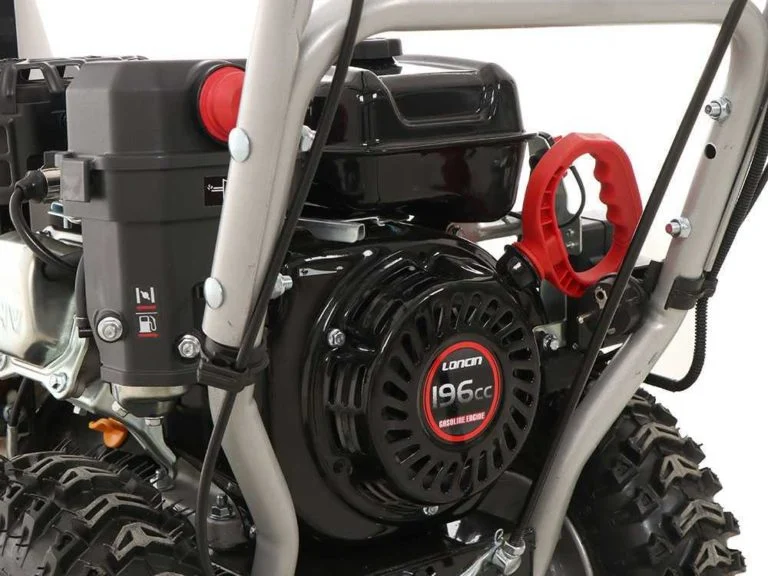
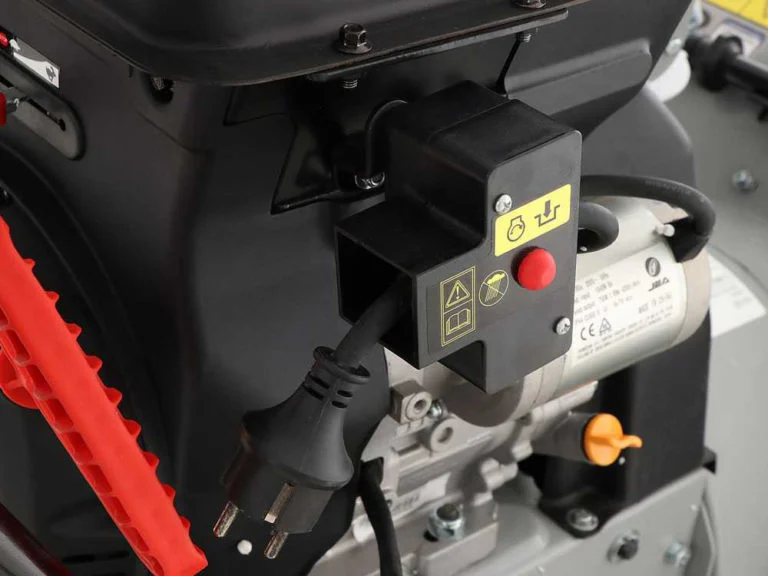
With regard to the starting system, we can find two possibilities: Recoil start and electic start.
IMPORTANT: In the case of an engine equipped with an electric start , there is no battery, as this system allows you to start the snow blower directly from the electrical outlet. This is because batteries, when subjected to sudden temperature changes, tend to run out quickly.
1.3 Changing engine oil
Regular checking and therefore changing of the engine oil is essential to ensure that the engine is working correctly and at its best.
Therefore, when preparing the snow blower for the new season, it is very important to replace the old oil that has remained stuck from the previous season inside the machine.
IMPORTANT: The oil must be completely changed at least once a season, even if the machine is stationary and unused. The type of oil to be used and how often to change it are always given in the relevant manual.
In this operation, the old oil is completely drained and replaced by a new oil suitable for cold temperatures.
Be sure to use a quality engine oil for the proper functioning of the snow blower during the winter.
1.4 Checking or replacing the spark plug

Another essential maintenance task at the beginning of the season is to check the condition and possibly replace the spark plugs.
Using clean spark plugs that are always in good condition will allow the engine to start immediately and smoothly.
Coming from a long standstill and especially from the entire working season, it is possible to find the spark plug in two different states:
- Simply dirty and with some slight incrustations :in this case it will be enough to clean it with a brush with metal bristles or a cloth slightly soaked in oil;
- Worn or even damaged: In this case, the spark plug must be replaced.
How do I replace it?
Replacing them is not a very complex procedure, but there are still some very precise steps to be taken, which for the inexperienced could be a major obstacle.
So let’s look at the main steps to check the condition of a spark plug and replace it if necessary:
- First, the spark plug, which is located near the engine compartment, must be identified;
- Remove the spark plug cap;
- Remove the spark plug using the appropriate jointed spanner. To unscrew the spark plug, an anti-clockwise movement is required. The spark plug, especially if it has never been pulled out, will present resistance to the action of the spanner.
At this stage, it is important to make firm, but not too vigorous movements, otherwise you risk breaking or ruining the header thread; - Once removed, it can be replaced with a new spark plug.
When the new spark plug is inserted in its seat, a first manual rotation is carried out and then the correct tightening is performed with the jointed spanner.
Also for the re-insertion phase, it is important to ensure that the spark plug is inserted correctly, in order to avoid serious damage to the engine.
1.5 Checking the condition of the blades and auger
The blades and auger must be sharp and undamaged. A damaged auger reduces the ability to remove snow effectively. Replace damaged parts with genuine parts.
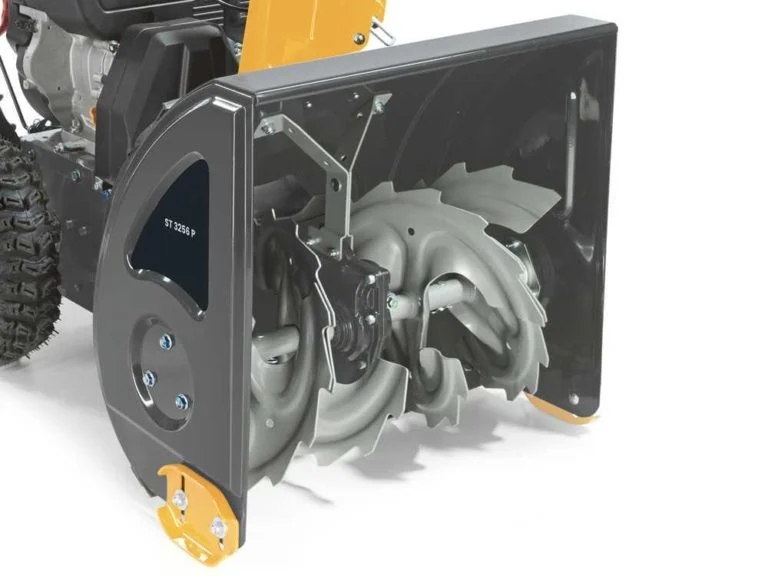
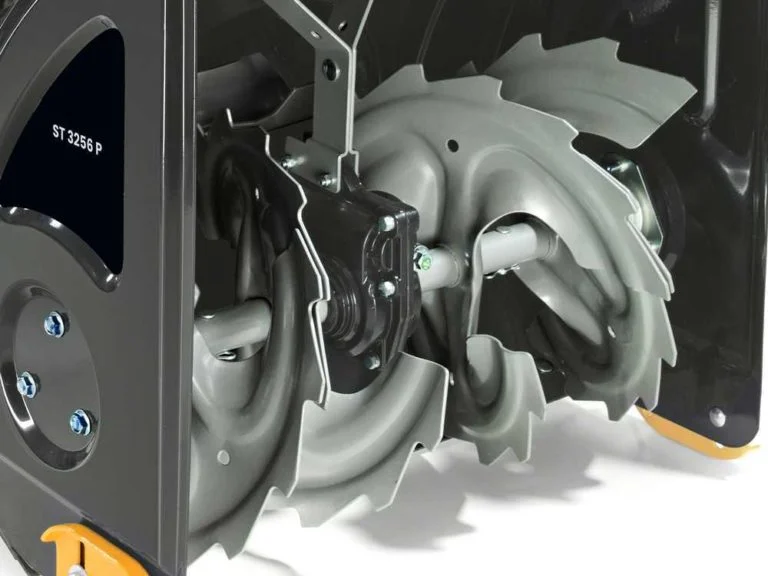
1.6 Tyre or Track Inspection
Check tyre pressure: flat tyres compromise the stability and traction of the snowplough.
If the model has tracks instead, make sure they are in good condition and well tensioned.
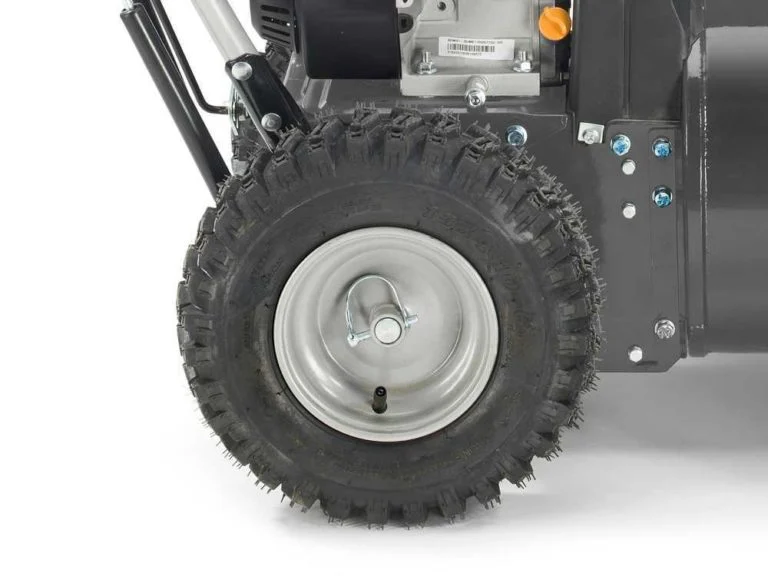
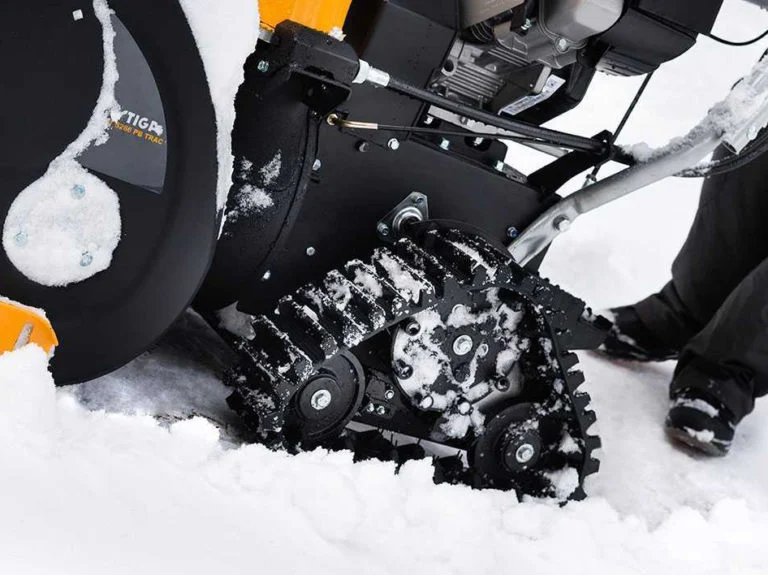
1.7 Checking the transmission, belts and exhaust system
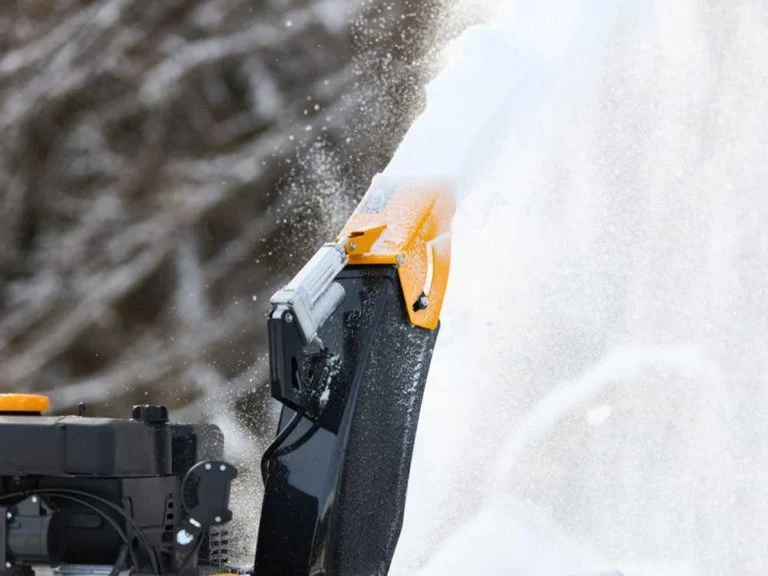
The drive belts must be undamaged and tight. Replace them immediately if they show signs of wear such as cracks or fraying.
Check that the transmission mechanisms work smoothly: a malfunction could compromise the efficiency of the snowplough during use.
Finally, check that the exhaust fan and tube are free of obstructions.
Obstructed flow may cause blockage or damage during use.
2. Routine maintenance
During the season, it is essential to keep the snow blower in good condition to ensure optimum and safe performance during use, to prevent sudden failures and reduce wear on components.
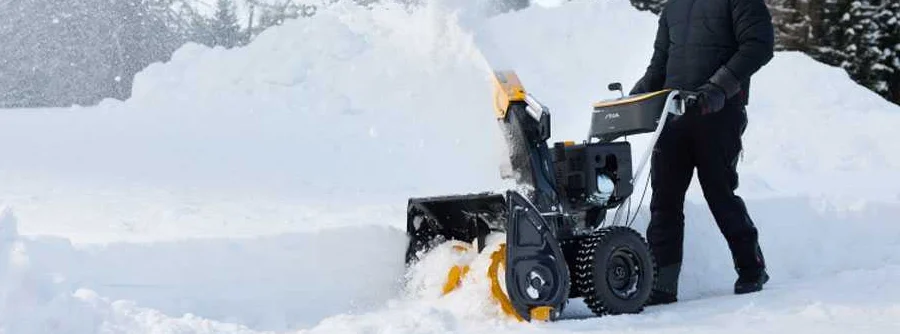
Routine maintenance involves work to be carried out regularly to maintain efficiency:
- Cleaning after each use.
- Blade check;
- Checking and possibly topping up the engine oil;
- Inspection of the transmission and brake system.
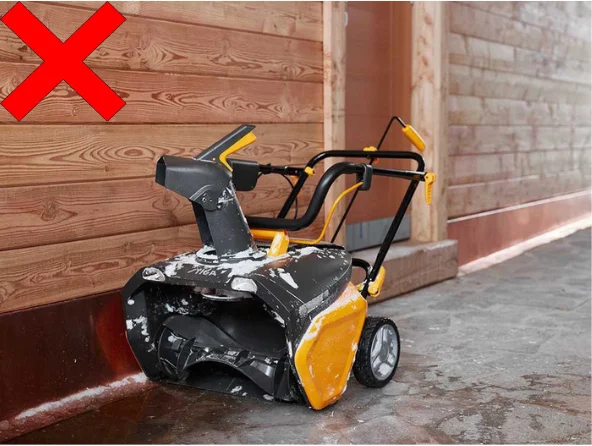
2.1 Cleaning after each use.
After each work session, it is best to remove any snow and ice from the snow blower that has become stuck and clean it properly.
To clean the machine properly, use a soft brush to avoid scratches and also pay special attention to the areas around the auger and discharge pipe to check for blockages.
If possible, dry the machine with a cloth to minimize any residual moisture that may cause corrosion.
2.2 Blade check
Regularly inspect the blades and auger for signs of wear or damage.
If blunted or deformed parts are noticed, they must be replaced immediately. An auger in good condition ensures optimal snow removal and reduces engine effort.
2.3 Checking and possibly topping up engine oil
The engine oil must always be at the correct level. Check the level with the dipstick and top up if necessary using oil suitable for cold temperatures. Change the oil according to the manual every 25–50 hours of use.
2.4 inspecting the Transmission and Brake System
Check that the transmission system is smooth and free of abnormal noises. If your snow blower is equipped with brakes, make sure they respond correctly and are not worn out, in the event of a malfunction, adjust or replace the necessary parts.
3. Operations before storage
When winter is over, it’s time to prepare your snow blower for downtime.
Correct maintenance in this last phase prevents damage due to corrosion, wear or malfunctions when re-used and then in the following season.
The interventions involved in this maintenance phase are:
- Cleaning the machine;
- Empty the fuel tank;
- Proceed to storage.
3.1 Cleaning the machine
Before storing the snow blower, clean it thoroughly, removing any snow, ice and dirt.
It also pays special attention to moving parts such as the auger and unloading tube, which must be completely dry to prevent rust.
3.2 Drain the fuel tank
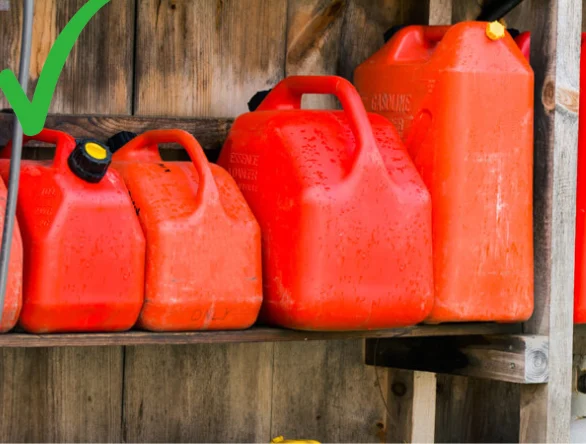
Fuel left in the tank for long periods can deteriorate, causing engine problems.
Empty the tank completely and start the engine to consume any residue in the pipes before storing your snow blower.
Alternatively, you can use a fuel stabiliser, following the manufacturer’s instructions.
A correct procedure for storing fuel is to leave it in special red canisters (picture alongside), which can protect it from cold and UV light.
3.3 Spark plug maintenance
Immediately after draining the tank, another very important operation is to perform a small maintenance step for the spark plug.
ADVICE: Once the spark plug has been removed, it is advisable to pour a teaspoon of oil into its housing to prevent the cylinder from blocking and then re-attach it properly.
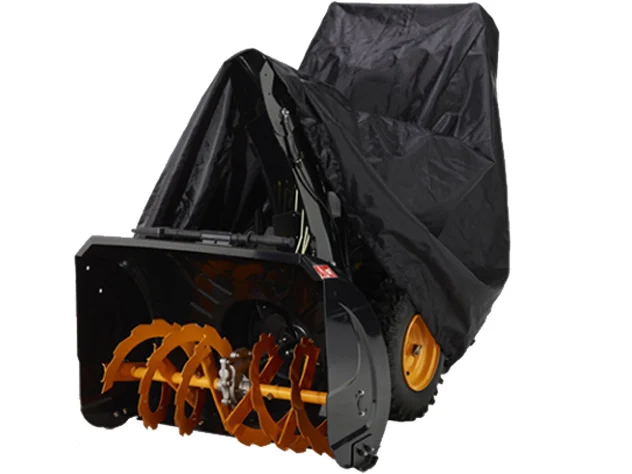
3.4 Storage
As the last step in this maintenance phase is the actual storage of the snow blower.
The machine must be kept in a dry place, protected from moisture and weather conditions during the period when the machine is not in use.
Advice: Cover it with a protective cover to prevent dust and dirt from accumulating on the machine. Make sure the cover is breathable to prevent condensation.
4. Maintenance of battery-powered models
As we said at the beginning of the drive, the maintenance of battery-powered models is much less demanding than that of the internal combustion engine models.
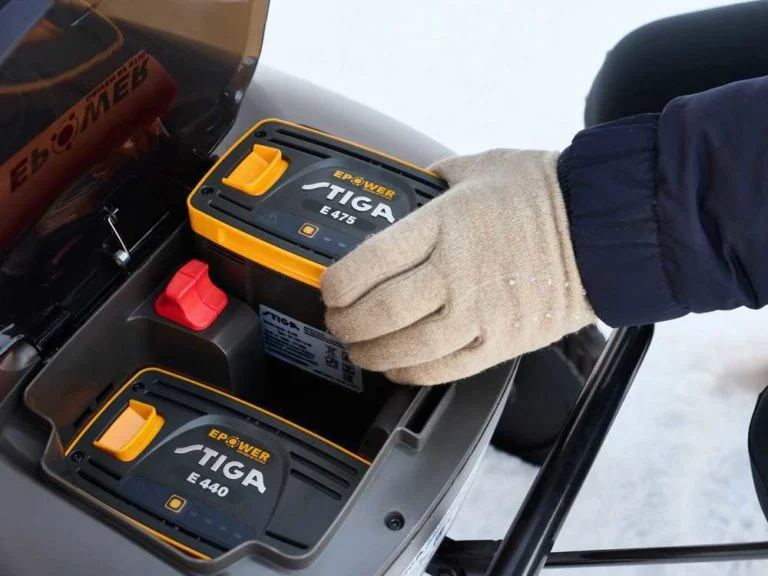
The main actions and precautions to be taken are:
- Testing and charging the battery;
- General machine check
- Checking the tyres or tracks;
- Storage.
The main and most important task is definitely to check the battery and its charge.
In addition to this step, the other actions are mainly to check and verify the general condition of the snow blower, along with checking that the tyres are properly inflated or the condition of the tracks, when present.
IMPORTANT: Out of season, a full battery recharge cycle should be carried out every three months.
In order to ensure that the battery system is maintained at its best, it is essential that it is fully recharged even when the machine is not in use.
5. What is needed for snow blowers maintenance?
Now let’s look at the materials, tools and also their PPE that are useful or necessary for maintenance.
5.1 Materials
- Engine oil specific for low temperatures;
- Lubricant for moving parts;
- Rust remover.
5.2 Tools and implements
- Spark plug removal spanners;
- Cleaning brush;
- Containers to dispose of used oil.
5.3 Clothing and PPE
- Protective gloves;
- Safety goggles;
- Waterproof clothing for working in the snow.
6. Frequently asked questions from our customers
Here are some of the most common questions about snow blower maintenance:
Check the oil level before each use. Change the oil according to the operating instructions, usually after every 20-50 operating hours or at least once a season.
Remove snow, ice, and debris from the auger, blow-out chimney, and other exposed parts with a plastic scraper to prevent paint damage. Make sure the device is dry to prevent rust.
Check the blades regularly. Replace if excessively worn or bent, and tighten auger bolts if necessary.
Check the spark plug every 50 hours of operation. Check that there is no dirt build-up and that the electrode spacing is correct.
Always use fresh, high-quality petrol. Add a fuel stabilizer if you're not going to use your snow blower for more than 30 days.
Empty the fuel tank or add a stabilizer to prevent deposits.
Lubricate moving parts and store the snowplough in a dry, covered place.
Controls the tire pressure (if pneumatic) and inflates to the manufacturer's specifications.
For the tracks, check that they are tight and free from cracks or wear.
Check that the ejection chimney is not obstructed. Check auger paddles for proper operation and replace if worn.



